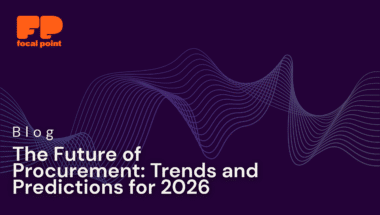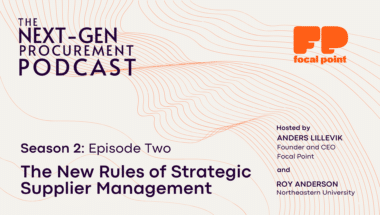This article was originally published in SG Voice.
Before 2021, when supply chain inefficiencies upended how consumers get what they need, procurement operated in the background—a business necessity, but not a driver of long-term value. Today, the role of procurement teams has moved beyond savings. With a wealth of data available, there is an opportunity for procurement leaders to drive significant contributions to an organization’s social and environmental goals.
Before 2021, when supply chain inefficiencies upended how consumers get what they need, procurement operated in the background—a business necessity, but not a driver of long-term value. Today, the role of procurement teams has moved beyond savings. With a wealth of data available, there is an opportunity for procurement leaders to drive significant contributions to an organization’s social and environmental goals.
- Historically, procurement was associated with cost savings, but today its role has evolved. Procurement teams are moving beyond traditional cost reduction to drive long-term value and contribute to an organisation’s ESG goals.
- By actively seeking sustainable practices from suppliers, promoting diversity, equity, and inclusion (DE&I), and tracking progress in real-time, procurement becomes a linchpin in fostering positive change and responsible business practices across the organisation.
- Procurement visibility safeguards the organization’s reputation and mitigates financial risks associated with potential misconduct. Proper permissions and controls help catch and prevent malpractices, emphasising the importance of responsible procurement beyond cost considerations.
To date, the biggest barrier to driving impact beyond savings has been a lack of visibility. Markers of corporate sustainability, like Scope 3 Greenhouse Gas Emission reporting, rely on data from your vendors and your vendors’ vendors to measure the effects of procurement operations across the value chain.
Beyond impact, visibility across all procurement processes empowers better decision-making to drive informed spending and saving with corporate social responsibility in mind.
Procurement will always be responsible for top-line spend reduction. But, with data emerging as a greater resource than at any time in the function’s history, procurement can contribute to the business’s long-term goals in several notable ways.
ESG Impact: identifying and eliminating unsustainable practices
In the contemporary landscape of corporate responsibility, the role of the procurement team is pivotal in steering organizations toward achieving their Environmental, Social, and Governance (ESG) goals. The procurement team serves as the gatekeeper, holding the key to identifying and eliminating unsustainable practices within the supply chain.
For instance, by actively seeking suppliers who prioritize renewable energy sources in their production processes or by favouring those committed to fair labour practices, procurement professionals can drive positive change. Choosing materials with lower carbon footprints and promoting circular economy principles are also at procurement’s discretion.
This proactive approach not only ensures the organization’s commitment to environmental sustainability but also fosters social responsibility and sound governance. In essence, the procurement team becomes a linchpin in the pursuit of ESG objectives, wielding influence over the entire value chain to create a lasting impact on the organization and the broader global community.
DE&I Integration: real-time tracking for supplier diversity
As organizations increasingly recognize the importance of Diversity, Equity, and Inclusion (DE&I) in their operations, the procurement team emerges as a crucial player in translating these principles into tangible outcomes. Procurement visibility enables you to track your DE&I vendor progress in real time versus in retrospect, again giving procurement influence over the larger organizations’ long-term impact.
By actively monitoring for and investing in a diverse supplier base, organizations can foster inclusivity and create economic opportunities for underrepresented groups. For example, setting and tracking specific goals for sourcing from minority or women-owned businesses, or companies with diverse workforce initiatives can contribute significantly to broader societal goals.
Technology-driven solutions that capture real-time data analytics enable procurement teams to assess and address the diversity profile of their suppliers promptly and adjust as necessary. This integration of DE&I considerations into procurement practices not only aligns with ethical business standards but also amplifies the positive impact an organization can have on the communities it serves.
E&C Assurance: a background check for ethical procurement
The same visibility that helps organizations identify diverse vendors can also bring problematic vendors to the surface. This data in aggregate essentially serves as a background check for the procurement team to base its sourcing decisions on. It is crucial to have vendors with ethics and compliance that align with your organization’s values.
Procurement visibility ensures that internal stakeholders are clear on where items are being sourced from, opening up the space to weed out any unintentionally unethical items that have found their way to your business. This not only safeguards the organization’s reputation but also
Mitigating risks and ensuring accountability
The movement of money, often millions of dollars, is inherently risky and can cause procurement employees to become desensitized to the value of the transactions they’re processing, leaving room for potential human error. Without the appropriate guardrails in place to ensure transactions are handled appropriately, funds are at risk of becoming misused.
Internal bad actors that get away with malpractice by having improper relationships with vendors, inappropriately handling money, or even by “skimming a little off the top” over time can result in millions of dollars in losses for the company. Proper permissions ensure that employee misconduct is caught early and often.
Procurement as a catalyst: beyond savings to responsible impact
Treating procurement as a tool that has the power to do more than just save money can be the catalyst for a substantial impact within your organization. As we navigate the complex intersections of business and societal values, procurement emerges not just as a strategic function but as a driving force behind an organization’s journey toward responsible and impactful operations. Beyond the bottom line, it is the conscientious decisions made by procurement teams that contribute to a more sustainable and equitable future. By fostering relationships with a diverse range of ethical suppliers, promoting inclusive business practices, and enabling the proper movement of money with the right guardrails in place, procurement’s role extends beyond savings to have a real impact on the longevity of the company.



